The Business Continuity Imperative: The Work Experience and Workforce Engagement Agenda
The workforce is the center of any organization, no matter if the workforce consists of employees, contractors or what we call gig workers. It stands to reason that a black-swan event has an immediate impact on a workforce and thus an organization’s overall business health. In challenging times, a “family-first” mentality tends to take hold — a reality that, far too often, business leaders and HR organizations underestimate. But organizational readiness is essential for sustainability and operational effectiveness.
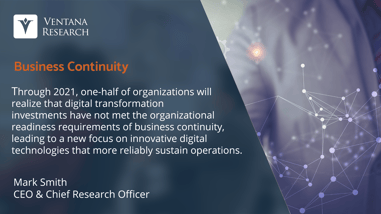
Maintaining business continuity is not an easy endeavor in a crisis such as a global pandemic. In fact, Ventana Research asserts that through 2021, one-half of organizations will realize that digital transformation investments have not met the organizational readiness requirements of business continuity, leading to a new focus on innovative digital technologies that more reliability sustain operations. The business continuity imperative demands that organizations make it a priority to examine areas that are often overlooked but that provide a meaningful work experience and effective workforce engagement to learn and improve. It’s critical that efforts to sustain a healthy relationship with the workforce start with leadership, from the executive team to managers. The health of every organization hinges on an effective work experience, and this requires technology investments that enable everyone to operate anywhere at any time.
Building Work Continuity
Every organization should start by assessing the short- and long-term business impact of all workforce engagement efforts and how well the work experience enables continuous operations. It is important to go beyond conventional wisdom; an organization may have its applications in the cloud and may have invested significantly into digital transformation, but that doesn’t’ mean that everything will be just fine. We have all witnessed the peril of this mindset. Many current approaches lack resiliency and require bold improvements in processes and technology.
Organizations should cultivate a work experience that encourages engagement and learning, which in turn bolsters productivity and overall performance. Doing this requires better intelligence and more streamlined automation of processes to ensure that virtual operations actually work.
An organization’s relationship with its workforce will always determine its success and building connections is impossible without high-quality, seamless digital experiences. In fact, Ventana Research asserts that by 2022, one-half of organizations will determine that the digital experiences they provide are not intelligent or automated and fall short in maintaining business continuity for organizational readiness, resulting in lost customers  and workforce instability.
and workforce instability.
Workforce success is about more than just ensuring levels of productivity and operating under pressure; it’s about the ability to sustain those efforts over time and rise to the demands of business continuity. A work experience imperative unifies an organization’s efforts to ensure sustainability through the best and worst of times and should provide continuity and engagement that exceeds expectations. Optimizing the work experience is more than just a nicety; it’s essential for every organization to optimize workforce engagement and learning for optimal relationships.
There’s more to work than a worker’s roles and responsibilities. What are your organization’s expectations around collaborating with and contributing to help peers, the team and the organization? Where can workers turn for support to ensure they have what they need from your organization? Do you allow flexible work hours to help them balance work with pressures from home? Answering these critical questions requires clear guidelines, processes and, importantly, communication.
Communication and related applications are an essential part of the work experience. Every organization must ensure it has technology that can operate on a mobile network from any connected device in a remote location, including from the couch and home office. Any work operation that impairs the work experience should be discarded. While organizations have spent significant resources and efforts on digital transformation in the form of automation and efficiency improvements, a far more important consideration is whether those investments provide the work experience desired and lead to better workforce engagement.
In times of crisis such as the current global health pandemic, when business continuity is a top priority, organizations mustn’t neglect the work experience, especially if it has not previously been a focal point of executive leadership or the HR team. The work experience is not just about tools and processes that improve worker productivity but management that supports the sustainability of work. How leadership manages work can establish the tone of the relationship with the workforce and can have profound impact on individuals’ ability to engage and learn to reach expected performance.
Digital Communications is Essential
Challenges such as a global pandemic or natural disasters demand digital communication across the workforce and even to customers, partners and suppliers; however, crises can shift priorities and engagement can suffer. Being responsive in immediate and initial communications is important but organizations must design an overall program that’s comprehensive across all channels and valuable to all parties. This is what resiliency and business continuity is all about.
Leaders must realize that as workforces go virtual and people work from home overcoming communication challenges is not as easy as it might seem. The work experience changes drastically in this environment as other aspects of home life — from dogs to kids and parents — become part of the background, sometimes distracting and hindering productivity. And while working from home is on the surface more flexible than working in an office, it can drain on the mental health of any worker or leader in an organization. To maintain confidence and trust in the organization, leadership and managers must communicate goals, learning opportunities and changes in plans with this context in mind. Carrying on as if business is usual or, worse, sending haphazard and unclear communications will severely diminish chances of gaining the workforce’s confidence and trust.
To operate effectively organizations must be able to provide trusted, secure and open communications to collaborate with the workforce, customers and suppliers. Ineffective and siloed digital communication hinders the engagement of the workforce and can lead to frustration simply due to a lack of transparency. Organizations also must remember that communication must support all device form-factors and simple digital experiences and remain accessible across mobile and location-specific networks. The risk of data loss to an organization is significant when assessing technologies and requires protection of intellectual property and privacy of information through the use of cybersecurity software and effective data governance.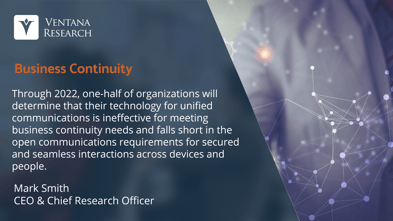
Specifically, today’s market for Unified Communications as a Service (UCaaS) and Communication Platform as a Service (CPaaS) technologies are blending rapidly as organizations realize the need for tools and platforms to unify communications in the cloud. Thus many organizations are beginning to establish an open communications imperative that ensures digitally secure communications across communication types and channels, bringing together an ecosystem of technologies to interoperate across the enterprise and external parties, customers and suppliers. This is critical and why we assert that through 2022, one-half of organizations will determine that their technology for unified communications is ineffective for meeting business continuity needs and falls short in the open communications requirements for secured and seamless interactions across devices and people.
In addition, machine learning and analytics are critical as these technologies provide a lens with which to not just monitor and detect but to predict and act on technical issues. Standard operation of these tools can identify patterns of communications that indicate fatigue or lagging work engagement so managers can get involved. Organizations must ensure their digital communications can interoperate with the necessary applications and provide mobile experiences that help engage the workforce.
Engaging an organization in new, virtual ways is essential to enacting work methods that best represent the organization’s values and optimize interactions with the workforce and beyond. While it’s important that an organization rally its digital communications efforts during a crisis such as a pandemic, trust in an organization is based on sincere interactions and an organization’s ability to deliver continuous engagement. Simply increasing the velocity of communications isn’t enough. Organizations must strive for valuable and sustainable interactions.
To be effective, an organization should establish best practices and policies that guide work experiences and interactions with the workforce for business continuity. Applications and systems must enable digital communications outside of normal operations. And importantly, organizations should engage in an active assessment of the work experience and use analytics to determine where challenges are arising or where a lack of communication highlights potential issues.
Work Experiences Matter
Many organizations have managed to optimize work within a business application but few of these applications support workers’ needs to learn and conduct tasks across a range of business processes. A quality work experience requires the right technology, which currently we don’t find in one business 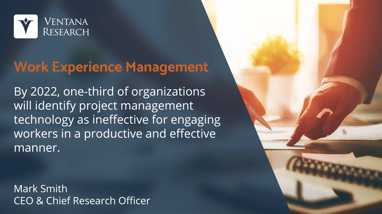 application or project management software. We assert that by 2022, one-third of organizations will identify project management technology as ineffective for engaging workers in a productive manner. It’s important that an organization make investments into supporting work management that uses automation and intelligence to optimize priorities and resources, simplifying the execution of tasks and activities to improve accountability. The current movement in technology for work management is focused on streamlining self-driven and continuous work of both workers and managers and balancing the routine with the not-so-routine tasks. Organizations must improve aspects of the experience such as assessing, prioritizing and executing work to optimize workforce engagement.
application or project management software. We assert that by 2022, one-third of organizations will identify project management technology as ineffective for engaging workers in a productive manner. It’s important that an organization make investments into supporting work management that uses automation and intelligence to optimize priorities and resources, simplifying the execution of tasks and activities to improve accountability. The current movement in technology for work management is focused on streamlining self-driven and continuous work of both workers and managers and balancing the routine with the not-so-routine tasks. Organizations must improve aspects of the experience such as assessing, prioritizing and executing work to optimize workforce engagement.
Using the right technology is foundational to success and creates opportunities for breakthrough growth that far exceeds mere productivity improvements. Sustainable growth in work management is only possible when the organization goes beyond conventional wisdom and looks to how it uses technology to work collaboratively with customers, partners and suppliers. Organizations with a unified approach to work management will find that it’s easier to achieve organizational agility, as blended open communication platforms can help increase the velocity of engaging in and executing work.
Organizations should also prioritize investments that will yield continuous insights on worker sentiments about the work experience. Namely, if an organization is unable to capture and monitor interactions and feedback from the organization, then it’s probably missing the insights it requires to effectively improve the work experience. Continuous feedback from the organization can help increase productivity but, more importantly, the effectiveness of the organization. Organizations should seek to establish or expand a Voice of the Employee (VoE) program with a set of processes and technology that uses feedback and sentiment from all workers, employees or not, along with analytics and machine learning to gain insights to optimize work experiences.
Smart Investments Matter
Organizations must consider whether investments in applications that support open and secure digital communications that are blended with work management meet organizational expectations. Investments should do more than automate tasks. We at Ventana Research assert that through 2022, one-quarter of organizations will invest into new technologies that optimize the use of resources and provide better digital work experiences. 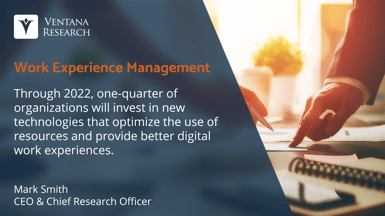
Smart investment requires an effective assessment of an array of applications and tools. An assessment should include the following questions:
- Do your open communication technologies support easy mobile and computer access to messaging and video conferencing, whether the conference includes one person or your entire organization?
- Are you able to have digital communications that enables workers to securely collaborate within your organization and with customers, partners and suppliers?
- Can you monitor and engage your organization based on its frequency of digital communications and work engagement?
- Have you performed resiliency testing to ensure all open communications and work management can operate efficiently in suboptimal conditions?
- Are you able to collaborate on specific work tasks to determine effective engagement in the activity assigned?
- Do you have the work management methods to optimize work and also to increase engagement in and improve the experience of work?
- Can you identify learning paths for work to engage the workforce to improve their contribution and performance?
- Are you able to assess satisfaction with the work experience and use feedback to make improvements?
- Can you assess your resources and then plan to adapt their use to maximize your workforce potential?
A “no” answer to any of these questions indicates risk that could directly impact an organization’s workforce potential. Every organization, no matter the industry, the number of its employees or the size, has an opportunity to significantly improve its work experience and engagement.
Furthermore, applications should do more than just enhance worker productivity and provide insights into work performance. It’s critical that an application enable leaders and managers to adequately plan for and adapt to changes, from black-swan events to meeting typical business continuity requirements. Organizations are unwise to even consider any investments that aren’t mobile-ready and powered with collaboration tools. We assert that by 2022, one-third of organizations will determine that their business applications are not suited to support their business continuity needs due to ineffective collaborative and mobile experiences, which are essential to operate seamlessly in a virtual environment.
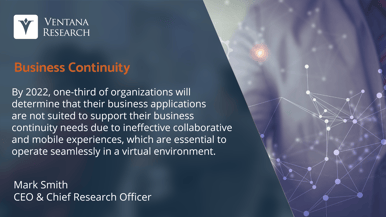 This continuous exercise of evaluation is a shared responsibility across business and IT leadership, and impossible to do without digital communications and work management technology. Antiquated methods such as messaging, spreadsheets, project management and other tools are not designed for a modern and digitally engaged organization. They are difficult to operate, diminish accountability and increase risk. It is critical that organizations, especially in times of duress, use business continuity as a driver to improve planning, intelligent use of communications and work, and thus examine their investments in technologies. Just as important is to provide leadership and managers the ability to instantaneously assess workforce engagement and potential worker learning to avoid work-related issues of fatigue or distractions.
This continuous exercise of evaluation is a shared responsibility across business and IT leadership, and impossible to do without digital communications and work management technology. Antiquated methods such as messaging, spreadsheets, project management and other tools are not designed for a modern and digitally engaged organization. They are difficult to operate, diminish accountability and increase risk. It is critical that organizations, especially in times of duress, use business continuity as a driver to improve planning, intelligent use of communications and work, and thus examine their investments in technologies. Just as important is to provide leadership and managers the ability to instantaneously assess workforce engagement and potential worker learning to avoid work-related issues of fatigue or distractions.
Next Steps
Collaboration and teamwork in an organization and continuous digital communications and work management are critical to the sustainability of the organization. The two most important aspects of the work experience for workforce engagement are digital communications and work management. This has inspired the role of Chief Digital Officer to look beyond just the traditional digital transformation efforts. A focus on communications and work is the foundation of every organization’s success.
If you are not sure how to approach improving the work experience and organizational performance through the lens of business continuity, there are specific steps that every organization should take, similar to the steps outlined in my perspective on the imperative for digital innovation in business continuity. The use of digital technologies to reinvent the work experience — from the inside out and from the outside in — requires the right lens that can support business continuity and not distract from it, which can ensure a more comprehensive approach. Most organizations have realized this and are making it a priority to be more prepared. We assert that by 2022, after a decade of concerted efforts in digital transformation, one-half of organizations will not have established business continuity as an investment priority and will not be prepared to operate in a future pandemic or crisis, which will lead to increased operational risks.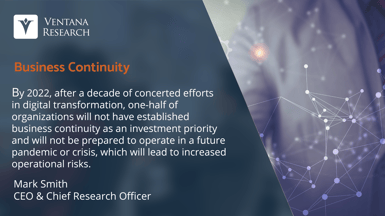
To achieve business continuity, optimize underlying work processes and technology for your organization along with what is used with customers, suppliers and partners. This can have an immediate impact on top- and bottom-line results and reflects the priority you place on your work experience. Once your organization has an effective approach to digitally secure and open communications along with the tools for work management and leadership committed to delivering an optimal work experience, you can be assured that your organization is built to last. Ensure that existing and future work management technology investments for effective engagement are designed for the work experience, not just for automation and efficiency.
Every individual in the workforce matters, no matter what role they play in your organizational efforts. The entire executive team — the CEO’s staff, the CMO, CFO, CIO, CCO, COO, CRO, CHRO and the Chief Digital Officer— should be aware of the strategy and plans for optimizing work experiences. Organizational leadership needs to ensure they embrace work management and the discipline it entails throughout the organization. The future depends on the active involvement of those who see building sustainable work experiences as fundamental to business continuity.
Determining your path forward for 2020 and beyond requires an effective strategy and an understanding of how to best sustain the required business continuity for your organization to learn and improve. Make sure you are using applications and technology for communications and work that can truly provide an effective work experience that’s focused on workforce engagement.
Regards,
Mark

Mark Smith
Partner, Head of Software Research
Mark Smith is the Partner, Head of Software Research at ISG, leading the global market agenda as a subject matter expert in digital business and enterprise software. Mark is a digital technology enthusiast using market research and insights to educate and inspire enterprises, software and service providers.









